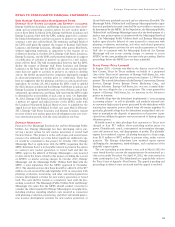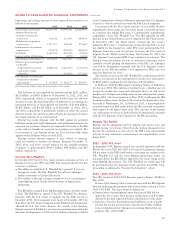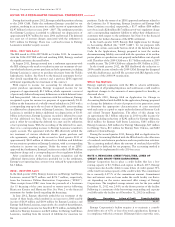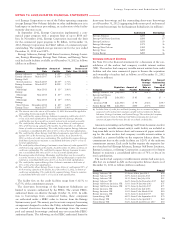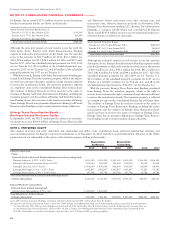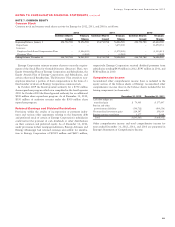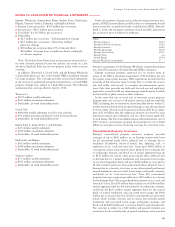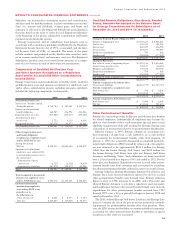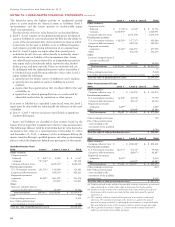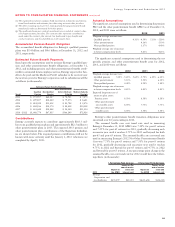Entergy 2012 Annual Report Download - page 87
Download and view the complete annual report
Please find page 87 of the 2012 Entergy annual report below. You can navigate through the pages in the report by either clicking on the pages listed below, or by using the keyword search tool below to find specific information within the annual report.
Entergy Corporation and Subsidiaries 2012
NOTES TO CONSOLIDATED FINANCIAL STATEMENTS continued
Entergy Wholesale Commodities Plants (Indian Point, FitzPatrick,
Pilgrim, Vermont Yankee, Palisades, and Big Rock Point)
n Primary Layer (per plant) - $500 million per occurrence
n Excess Layer - $615 million per occurrence
n Total limit - $1.115 billion per occurrence
n Deductibles:
n $2.5 million per occurrence - Turbine/generator damage
n $2.5 million per occurrence - Other than turbine/
generator damage
n $10 million per occurrence plus 10% of amount above
$10 million - Damage from a windstorm, flood, earthquake,
or volcanic eruption
Note: The Indian Point Units share in the primary and excess lay-
ers with common policies because the policies are issued on a per
site basis. Big Rock Point has its own primary policy with no excess
coverage.
In addition, Waterford 3, Grand Gulf, and the Entergy Wholesale
Commodities plants are also covered under NEIL’s Accidental Outage
Coverage program. This coverage provides certain fixed indemnities
in the event of an unplanned outage that results from a covered NEIL
property damage loss, subject to a deductible period. The following
summarizes this coverage effective April 1, 2012:
Waterford 3
n $2.95 million weekly indemnity
n $413 million maximum indemnity
n Deductible: 26 week deductible period
Grand Gulf
n $400,000 weekly indemnity (total for four policies)
n $56 million maximum indemnity (total for four policies)
n Deductible: 26 week deductible period
Indian Point 2, Indian Point 3, and Palisades
n $4.5 million weekly indemnity
n $490 million maximum indemnity
n Deductible: 12 week deductible period
FitzPatrick and Pilgrim
n $4.0 million weekly indemnity
n $490 million maximum indemnity
n Deductible: 12 week deductible period
Vermont Yankee
n $3.5 million weekly indemnity
n $435 million maximum indemnity
n Deductible: 12 week deductible period
Under the property damage and accidental outage insurance pro-
grams, all NEIL insured plants could be subject to assessments should
losses exceed the accumulated funds available from NEIL. Effective
April 1, 2012, the maximum amounts of such possible assessments
per occurrence were as follows (in millions):
Utility:
Entergy Arkansas $21.9
Entergy Gulf States Louisiana $18.9
Entergy Louisiana $22.0
Entergy Mississippi $0.07
Entergy New Orleans $0.07
Entergy Texas n/a
System Energy $18.4
Entergy Wholesale Commodities $ –
Potential assessments for the Entergy Wholesale Commodities plants
are covered by insurance obtained through NEIL’s reinsurers.
Entergy maintains property insurance for its nuclear units in
excess of the NRC’s minimum requirement of $1.06 billion per site
for nuclear power plant licensees. NRC regulations provide that the
proceeds of this insurance must be used, first, to render the reactor
safe and stable, and second, to complete decontamination opera-
tions. Only after proceeds are dedicated for such use and regulatory
approval is secured would any remaining proceeds be made available
for the benefit of plant owners or their creditors.
In the event that one or more acts of terrorism causes property
damage under one or more or all nuclear insurance policies issued by
NEIL (including, but not limited to, those described above) within 12
months from the date the first property damage occurs, the maximum
recovery under all such nuclear insurance policies shall be an aggre-
gate of $3.24 billion plus the additional amounts recovered for such
losses from reinsurance, indemnity, and any other sources applicable
to such losses. The Terrorism Risk Insurance Reauthorization Act of
2007 created a government program that provides for up to $100
billion in coverage in excess of existing coverage for a terrorist event.
Conventional Property Insurance
Entergy’s conventional property insurance program provides
coverage of up to $400 million on an Entergy system-wide basis
for all operational perils (direct physical loss or damage due to
machinery breakdown, electrical failure, fire, lightning, hail, or
explosion) on an “each and every loss” basis; up to $400 million in
coverage for certain natural perils (direct physical loss or damage due
to earthquake, tsunami, and flood) on an annual aggregate basis; up
to $125 million for certain other natural perils (direct physical loss
or damage due to a named windstorm and associated storm surge)
on an annual aggregate basis; and up to $400 million in coverage for
all other natural perils not previously stated (direct physical loss or
damage due to a tornado, ice storm, or any other natural peril except
named windstorm and associated storm surge, earthquake, tsunami,
and flood) on an “each and every loss” basis. The conventional
property insurance program provides up to $50 million in coverage
for the Entergy New Orleans gas distribution system on an “each and
every loss” basis. This $50 million limit is subject to: the $400 million
annual aggregate limit for the natural perils of earthquake, tsunami,
and flood; the $125 million annual aggregate limit for the natural
perils of named windstorm and associated storm surge; the $400
million per occurrence limit for all other natural perils not previously
stated, which includes tornado and ice storm, but excludes named
windstorm and associated storm surge, earthquake, tsunami, and
flood; and the $400 million per occurrence limit for operational perils.
The coverage is subject to a $40 million self-insured retention per
occurrence for the natural perils of named windstorm and associated
85


